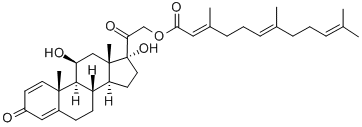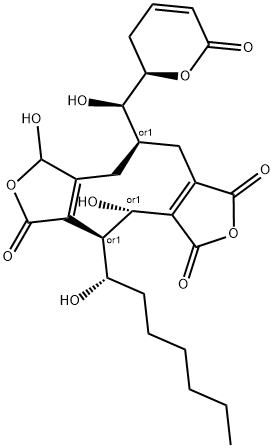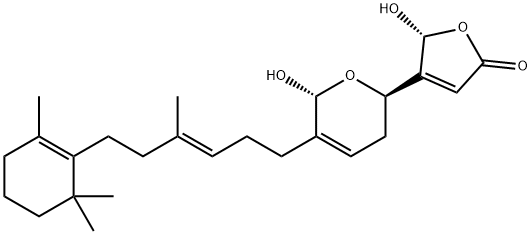GERANIC ACID
Synonym(s):3,7-Dimethyl-2,6-octadienoic acid
- CAS NO.:459-80-3
- Empirical Formula: C10H16O2
- Molecular Weight: 168.23
- MDL number: MFCD00036493
- EINECS: 207-299-9
- SAFETY DATA SHEET (SDS)
- Update Date: 2024-12-18 14:15:30

What is GERANIC ACID?
Chemical properties
Colorless viscous liquid; neat; sweet, foral green, geranium leafike, woody with a citrus orange body nuance.
Occurrence
Reported found in tea, tomato and wine
The Uses of GERANIC ACID
Possible uses: orange, tea, mint, ripe fruit and melon notes.
What are the applications of Application
Geranic acid is a branched carboxylic acid compound for organic synthesis and proteomics research
Definition
ChEBI: Geranic acid is a polyunsaturated fatty acid that is octa-2,6-dienoic acid bearing two methyl substituents at positions 3 and 7 (the 2E-isomer). It has a role as a pheromone, an EC 1.14.18.1 (tyrosinase) inhibitor, a plant metabolite, an antifungal agent and a melanin synthesis inhibitor. It is a polyunsaturated fatty acid, a methyl-branched fatty acid, a monoterpenoid and an alpha,beta-unsaturated monocarboxylic acid. It is a conjugate acid of a geranate.
Production Methods
Geranic acidacid is produced
1) from 2-Methylhepten-2-one-6 with Iodoor Bromoacetic ester and a Zinc type catalyst.
2) by oxidation of Citral.
Aroma threshold values
Medium strength odor, green type; recommend smelling in a 10.0% solution or less.
Taste threshold values
Sweet, woody, leafy, fruity body with some mouthfeel effects at 20 ppm.
General Description
Geranic acid is a monoterpenemainly used in flavor, fragrance, cosmetics and agro-industries. In vitro studies show that geranic acid exhibits strong inhibitory activity against Fusarium graminearum and Colletotrichum graminicola, the two main fungal pathogens of maize. It may be responsible for the potent tyrosinase inhibitory activity of lemongrass (Cymbopogon citratus).
Biochem/physiol Actions
Odor (neat): sweet, floral green, geranium leaf-like, woody with a citrus orange body nuance.
Properties of GERANIC ACID
| Melting point: | 185-186 °C (decomp) |
| Boiling point: | 250 °C(lit.) |
| Density | 0.97 g/mL at 25 °C(lit.) |
| refractive index | n |
| FEMA | 4121 | GERANIC ACID |
| Flash point: | >230 °F |
| storage temp. | Sealed in dry,Room Temperature |
| solubility | H2O: insoluble |
| pka | 5.17±0.33(Predicted) |
| color | Colorless liquid, slightly viscous, and increasing in viscosity with age or exposure to air and daylight. |
| Odor | at 10.00 % in propylene glycol. dry weedy acidic green moldy feet woody |
| JECFA Number | 1825 |
| BRN | 1763804 |
| CAS DataBase Reference | 459-80-3(CAS DataBase Reference) |
| EPA Substance Registry System | 2,6-Octadienoic acid, 3,7-dimethyl- (459-80-3) |
Safety information for GERANIC ACID
| Signal word | Warning |
| Pictogram(s) |
 Exclamation Mark Irritant GHS07 |
| GHS Hazard Statements |
H312:Acute toxicity,dermal H315:Skin corrosion/irritation |
| Precautionary Statement Codes |
P264:Wash hands thoroughly after handling. P264:Wash skin thouroughly after handling. P280:Wear protective gloves/protective clothing/eye protection/face protection. P332+P313:IF SKIN irritation occurs: Get medical advice/attention. P501:Dispose of contents/container to..… |
Computed Descriptors for GERANIC ACID
New Products
Tert-butyl bis(2-chloroethyl)carbamate (S)-3-Aminobutanenitrile hydrochloride N-Boc-D-alaninol N-BOC-D/L-ALANINOL 3-(2,4-Dimethoxybenzyl)dihydropyrimidine-2,4(1H,3H)-dione 7-Bromo-1H-indazole N-octanoyl benzotriazole 3,4-Dibenzyloxybenzaldehyde 4-Hydrazinobenzoic acid Electrolytic Iron Powder Fmoc-Val-Cit-PAB 1,1’-CARBONYLDIIMIDAZOLE R-2-BENZYLOXY PROPIONIC ACID 4-HYDROXY BENZYL ALCOHOL 1,1’-CARBONYLDI (1,2-4 TRIAZOLE) S-2-CHLORO PROPIONIC ACID (2-Hydroxyphenyl)acetonitrile 4-Bromopyrazole 5-BROMO-2CYANO PYRIDINE 5,6-Dimethoxyindanone 5-broMo-2-chloro-N-cyclopentylpyriMidin-4-aMine 1-(4-Methylphenylsulfonyl)-1H-1,2,3-benzotriazole 1-(2-Chlorobenzyl)-4-nitro-1H-pyrazole 1-(2-Nitrophenyl)-4-phenylpiperazineRelated products of tetrahydrofuran








You may like
-
 459-80-3 GERANIC ACID 98%View Details
459-80-3 GERANIC ACID 98%View Details
459-80-3 -
 Geranic acid CAS 459-80-3View Details
Geranic acid CAS 459-80-3View Details
459-80-3 -
 Ste-Glu-AEEA-AEEA-OSUView Details
Ste-Glu-AEEA-AEEA-OSUView Details
1169630-40-3 -
 1446013-08-6 Fmoc-His-Aib-OH TFA 98%View Details
1446013-08-6 Fmoc-His-Aib-OH TFA 98%View Details
1446013-08-6 -
 127464-43-1 99%View Details
127464-43-1 99%View Details
127464-43-1 -
 Chloro Uracil 99%View Details
Chloro Uracil 99%View Details
1820-81-1 -
 2-ETHYLPYRIDINE 100-71-0 99%View Details
2-ETHYLPYRIDINE 100-71-0 99%View Details
100-71-0 -
 13162-05-5 99%View Details
13162-05-5 99%View Details
13162-05-5